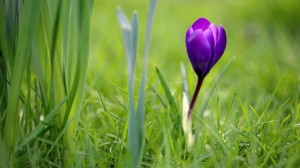Volunteer Mentor Network
Grow Wild Volunteer Mentor Network
for more details visit their website:-
https://www.growwilduk.com/content/join-our-volunteer-mentor-network
Fruit Tree Pruning Workshop
Wednesday 16 March, 10.30am-2.30pm
Rose Garden Orchard, Old Rutherglen Road, Gorbals, G5 0RE
Learn how to prune mature fruit trees so they’ll be healthy and productive with this free practical workshop led by The Urban Orchard Project. You will also be helping to maintain the Rose Garden Orchard – Glasgow’s oldest community orchard – for all to enjoy! No experience necessary. Tools, gloves, free lunch and hot refreshments provided. Please wear old clothes, waterproofs and outdoor shoes. To keep up to date with activities in the orchard visit:
www.facebook.com/RoseGardenOrchard/
For more information contact:
Clementine@theurbanorchardproject.org / 07872071712
Remember Potato Day this Sunday
 Remember – Glasgow Allotment Forum will be holding their 5th GAF POTATO DAY on Sunday 28th February, 11am-3pm at The Reidvale Neighbourhood Centre 13 Whitevale St, Dennistoun Glasgow, G31 1QW
Remember – Glasgow Allotment Forum will be holding their 5th GAF POTATO DAY on Sunday 28th February, 11am-3pm at The Reidvale Neighbourhood Centre 13 Whitevale St, Dennistoun Glasgow, G31 1QW
All are welcome, so please spread the word to friends, family, schools, work-mates and fellow gardeners. Once again we will be joined by Glasgow Food Network who will be running a seed-swap table. There will be workshops and a café (!)
This year we have over 50 varieties of seed potato, the majority of which are Scottish grown –a draft list is on the GAF web site now, but please remember it is not definitive yet. You will find old favourites as well as new additions and can again buy from as little as 1 tuber to larger amounts, although the day is more about variety than quantity. There will be onion sets, shallot sets and garlic as well as fertiliser and potato planter bags. Please support our ‘Tattie Bash’ and grow a potato for charity. For the princely sum of £2 you will be given a pot + 1 seed potato tuber and asked to go away and grow your potato, returning in August to one of our ‘weigh-ins’ to see who can grow the heftiest crop of tatties with all proceeds going to the charity WaterAid; from a land of plenty water we’ll be helping people in parts of the world with little access to any water, let alone anything like the clean, safe drinking water we enjoy. http://www.wateraid.org
Please bring a bag for yourself but also any spare carrier bags for re-use. We will have re-usable cotton bags for sale. Gardening Magazines swap: we will have a point for swapping gardening magazines, so if you have any back issues you’d like to give away, please bring them along.
We also hope to have a recipe board going on so please bring your favourite potato recipe and pin it on the board (we’ll also have pens and paper to hand).
Winter Pruning
It’s still not too late to do some pruning of you fruit trees and bushes. Here are some thoughts from a “proper gardener” George Anderson:-
Winter Pruning.
Pruning is done to remove dead, dying and diseased branches,  and allow light and air to the centre of the plant. Lack of air movement encourages the growth of fungus and increases the chance of rotting.
and allow light and air to the centre of the plant. Lack of air movement encourages the growth of fungus and increases the chance of rotting.
Curved blade secateurs give a clean cut whereas an anvil blade crushes the stem, allowing disease spores to be drawn in. Use loppers or a saw for thick stems.
Top Fruit e.g. apple or pear
Cordon – Plant tree sloping to the north to allow the sun along the whole of the tree, so distributing growth along the full stem and better distribution of buds up the tree. Cut off side shoots to 6 inches to encourage fruit buds near the stem. Aim for 6 branches per tree. One shoot will grow as the leader showing apical dominance. The vegetative buds are small and are at the top of the leader whereas the fruit buds are fatter and grow on top of a wrinkly piece of wood. Take the vegetative section back by about one third to about 6 inches.
Espalier – Cut off the tip of the leader. Cut off any branches which can’t be tied into shape.
Bush – Treat each branch as a Cordon.
SOFT FRUIT
Gooseberries, Red currants and White Currants: Fruit grows on old wood and basal part of young wood. 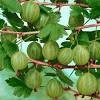 The fruit buds are the pointy fat buds. Take back side shoots to 2 buds. You need to make space round each branch to allow access to pick the fruit. Create space in the middle of the bush to create air flow and cut off any branches too near the ground, as these bushes need a 6”(15cm) leg to keep the fruit off the ground.
The fruit buds are the pointy fat buds. Take back side shoots to 2 buds. You need to make space round each branch to allow access to pick the fruit. Create space in the middle of the bush to create air flow and cut off any branches too near the ground, as these bushes need a 6”(15cm) leg to keep the fruit off the ground.
Prunings can be used as cuttings. Take an 8” (20cm) pruning and remove buds from bottom 6” (15 cm). Insert the 6” of stem in ground. When rooted, plant about 2” (5cm) deep. The remainder will not shoot because you have removed the buds and will become the leg of the bush.
Plums: Only prune to keep within bounds. Prune thick branches in summer ONLY, but thin small branches can be pruned in winter. Fruit buds are on young growth. The thick wood is the structure of the plant.
Cherries: Treat like plums, so prune to keep within bounds. Cover with fleece in spring to protect flowers from frost.
Blackcurrants: The fruit grows on young wood of the previous year’s growth, so there needs to be a lot of young growth, i.e. shoots from the base of the plant. Remove crossing branches and clear out the centre. Don’t prune the tips, unless the bush is much too tall.
Prunings can be used as cuttings. Take an 8” (20 cm) pruning and insert 6” (15cm) into the ground. Leave the buds on the cutting as these will become shoots when it is rooted and planted at around 2” (5 cm) deep.
Raspberries: Remove all old fruiting canes  from summer fruiting varieties. Tie in new canes to wire. 6 canes per clump. Best planted on a slight ridge. Autumn fruiting raspberries should be cut down totally to ground in winter. If a stalk is left, it will produce summer raspberries on it, and autumn raspberries on the new growth.
from summer fruiting varieties. Tie in new canes to wire. 6 canes per clump. Best planted on a slight ridge. Autumn fruiting raspberries should be cut down totally to ground in winter. If a stalk is left, it will produce summer raspberries on it, and autumn raspberries on the new growth.
Loganberry, Tayberry, Bramble: Take out all old fruit branches to base, since growth comes from the ground. Allow 5 new strong canes per plant. Remove excess side shoots from new shoots and shorten, if necessary. Bundle up loose shoots and tie to post or create a framework.
Blueberries: These bushes need very acid soil. Fruit is formed on 2nd and 3rd year branches, so only remove branches that are weak, crossing or close to the soil, or over 4 years old.
February Committee Meeting
Growing Well Together
This event is for sharing best practice and collaboration between community gardens, the NHS and other health care services
Date: Thursday 3rd March 10.00-16.00.
Venue: North Glasgow Homes, Saracen House, 139 Saracen Street, Possilpark, Glasgow, G22 5AZ
See the Event Programme
February Tips
Starting Seeds in Low Light
Even starting seeds off indoors or under heat in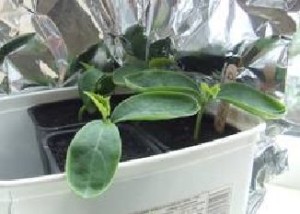 a greenhouse can be a bit tricky. The problem is lack of daylight hours. The days are getting longer but we’re quite a way off the spring equinox where day and night are equal length on March 20th. Lack of light results in leggy seedlings that never seem to do as well as their later planted sisters.
a greenhouse can be a bit tricky. The problem is lack of daylight hours. The days are getting longer but we’re quite a way off the spring equinox where day and night are equal length on March 20th. Lack of light results in leggy seedlings that never seem to do as well as their later planted sisters.
One trick to increase the amount of light to try and stop leggy seedlings is to put a mirror at the back of the propagator to reflect light back onto them. Some shiny kitchen foil stuck to cardboard makes a good cheap mirror. Just swap the seed tray around each day to stop them being drawn to the window.
Photo and article courtesy of allotment forum
Soil Testing
We all know that good soil leads to good crops. Plenty of humus from home-made composts and manure for structure is a good starting point but don’t ignore the acidity (pH) and major nutrients (N,P,K).
Plenty of humus from home-made composts and manure for structure is a good starting point but don’t ignore the acidity (pH) and major nutrients (N,P,K).
In some ways, acidity is the most important. A sour or acid soil blocks access to nutrients. It doesn’t matter how much food is in the soil if the plants can’t absorb it. Adding more fertiliser to sour soil is near pointless but lime will sweeten it and plants thrive again.
Often a soil isn’t just exhausted, it’s actually short of one specific element. It may have plenty of nitrogen available from manure but be short of potash (potassium) or phosphorus. Adding a fertiliser that is rich or purely the specific element missing is the most efficient way to correct this situation.
The only accurate way to find out what your soil’s acidity and nutrient levels are is to use a test kit. These are relatively cheap to buy and we’ve managed to get us a discount on a test kit from Two Wests – see below.
The tests are fairly easy to use but the important thing is to get the initial sampling right. If you have a three or four part rotation, treat each section as a separate plot. On each plot, imagine a large W. Take a sample from the 3 top points and 2 bottom points to give 5 in all.
The samples should be from about 10cm (4”) below the surface. Make sure your trowel is wiped between samples to avoid cross-contamination.
Once you know your soil, you can effectively improve it and, in turn, get much better crops. Not only more productive but more disease and pest resistant.
Soil Test Kit Offer – Save £2.00
This Soil Testing Kit is designed to let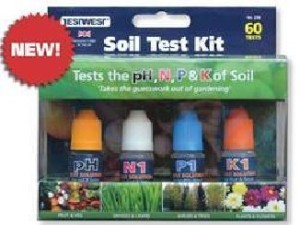 you test your soil for pH, phosphorus, nitrogen and potash. The kit includes sufficient chemicals for you to carry out approximately 50 tests and includes a unique filtering device for quick results.
you test your soil for pH, phosphorus, nitrogen and potash. The kit includes sufficient chemicals for you to carry out approximately 50 tests and includes a unique filtering device for quick results.
Just follow this link to Two Wests & Elliott web site and the discount should be applied automatically of use the code JHST at the checkout. Although you may find it cheaper elsewhere on the Internet.
Chitting Potatoes
If you’re chitting your potatoes in a shed or garage,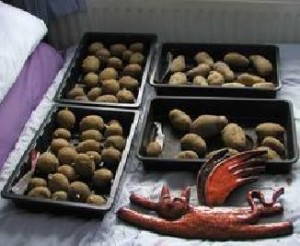 watch out for very cold nights. If they get frosted at this stage your chances are pretty slim. I just pop a folded horticultural fleece on them in cold weather but if it’s really cold bring them indoors
watch out for very cold nights. If they get frosted at this stage your chances are pretty slim. I just pop a folded horticultural fleece on them in cold weather but if it’s really cold bring them indoors
Photo: Potatoes on the bed in the spare room.
Shallots
Another crop to get in as soon as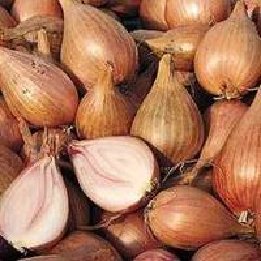 the weather improves if you’ve not already done so is your shallots. One of the easy crops to grow, I think easier than onions, shallots have the advantage of storing for longer. Fleece is very useful for protecting them from pigeons who often pull them up when they start to shoot.
the weather improves if you’ve not already done so is your shallots. One of the easy crops to grow, I think easier than onions, shallots have the advantage of storing for longer. Fleece is very useful for protecting them from pigeons who often pull them up when they start to shoot.

